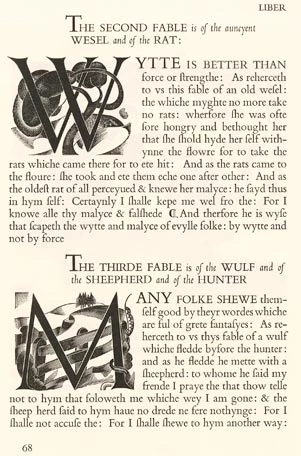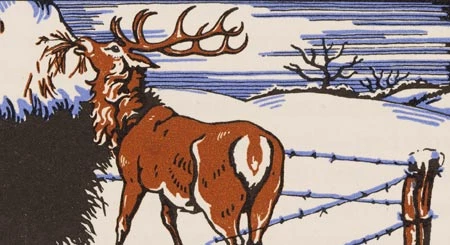The Gregynog Press
The Davies Sisters of Gregynog
The frontispiece to The stealing of the mare (1930), the work of Robert Maynard.
One of the outstanding aspects of the Davies sisters' involvement in the arts was the creation of the Gregynog Press. This was the only component of the arts and crafts scheme planned for Gregynog Hall to be implemented, beginning production in 1922. The first book, Poems by George Herbert, was published a year later, the last being published in 1940.
The Gregynog Press, like other private presses of the time, produced high quality books in limited editions. Such books were usually superbly printed on handmade paper, using hand presses or small letterpress machinery. Many of the greatest wood engravers of the twentieth century were commissioned to produce illustrations for these books.
The sisters already possessed books from some of the finest private press productions of the late nineteenth and early twentieth centuries, such as those from the Kelmscott and Ashendene presses.
Staff
One of the specially bound copies of the Loyal Address to King George V on the formal opening of the National Museum of Wales on the 21 April 1927.
At its peak, the Press employed seventeen staff. Most of the general workforce in the composing room and the bindery was Welsh and local to Gregynog. The artistic staff came mainly from England and Scotland.
The Gregynog Press Board had three aims in the production of fine books: to print books in the Welsh language, to publish some of the best examples of Anglo-Welsh literature and to publish translations of Welsh works.
From the 1930s the subject matter was more varied. Of the forty-two books, eight were in Welsh, while a further eleven had a Welsh connection. It is this attention to Welsh material that was one of the distinguishing features of the Press.
Loyal Address of the King
(1932). Agnes Miller Parker's wood engravings for this book, and XXI Welsh gypsy folk-tales (1933), established her as one of the greatest wood engravers of the twentieth century.
One of the more handsome productions was for Amgueddfa Cymru, and undertaken at a few weeks notice. This was the printing of the Loyal Address read at the formal opening of the Museum on 21st April 1927 by King George V, accompanied by Queen Mary. A number of copies were bound in blue levant morocco, decorated in gilt.
Printing
Illustrated page of Psalm XC from Psalmau Dafydd (1929)
The first 'Press' book, Poems by George Herbert, was printed on an Albion hand press. Most of the printing at Gregynog was done on the less labour-intensive Victoria, although William McCance, the second controller of the Press, used the Albion to print his first book, John Milton's Comus, in 1931.
The first four books were restricted to a single typeface (Kennerley), but soon it became possible to use a range of types. A Gregynog type was made, but it was only used for one book (Eros and Psyche, 1935).
The paper used at Gregynog was handmade. From 1927 to aid the process of printing this was done on dampened paper, a widely used technique.
The outstanding quality of the printing of the letterpress and the wood engravings was largely due to Herbert Hodgson, printer from 1927 until 1936.
Wood Engravings
Illustration from The story of the red-deer (1935/6), a children's book, which was the only book produced at Gregynog where the illustrations were printed in colour.
Some of the finest books ever illustrated with wood engravings were printed in Britain between the two world wars. The Press played a major part in this era. In the 1930s, the Gregynog Press saw one of the most outstanding periods of book illustration in Britain, with the sensuous engravings of Blair Hughes-Stanton and the intricate ones of Agnes Miller Parker.
A small number of external artists were commissioned to prepare engravings, one of the best known of whom was David Jones; his two engravings were printed in Llyfr y Pregeth-wr, the Book of Ecclesiastes.
Bindings
Illustrated capital from The stealing of the mare (1930)
The Gregynog Press was unique amongst private presses in that the binding of the books was seen as being as important as the printing. Up to 1935 each title was bound in buckram cloth or marbled paper, with one in vellum, but a small number of 'specials', were bound in full leather, of varying colours and designs.
Almost all the specials were bound by Fisher, who is recognised as one of the greatest bookbinders of the twentieth century. His versatility is shown at its best in the implementation of the designs prepared by McCance and Hughes-Stanton, notably for The Fables of Esope, The Revelation of Saint John the Divine and The Lamentations of Jeremiah. Other 'specials' were designed by the artistic staff including Maynard and Hughes-Stanton.
Images: Gwasg Gregynog/Gregynog Press






Comments - (4)
Does the National Museum Wales have a copy of the Gregynog Press's 1927 Caneuon Ceiriog? Also, there is a small room at the end of the French Impressionist gallery dedicated to the Davies sister's. In that room is a vitrine that held an example of one of the press's books. It has been missing for three years. Can you please tell me what book that is?
I am writing from France, where now we have lived for 15 years. I worked a long, long time ago, and for too short a time, at Gwasg Gregynog. It was, and remains for me (now at the age of 70+) my idyllic space of time in a mad world. A magical, creative and formative part of my psyche.
I would like so much to pass a short message to David Vickers, my mentor. A "feet on the ground", inspirational man who knows so much and believes so much in what he does. I would like him to know that I am writing, illustrating, and moving on to self-publishing (with stories for 4 grand-children in mind), and, after ALL these years, I regret having returned to him the beautiful white bone paper "folding tool" that I used so much at Gwasg Gregynong, and wish I still had!
Cordialement,
Sheila Poulton
Dear David Vickers,
Thank you very much for your comment. The text of this article is taken from an exhibition on the Davies sisters held at National Museum Cardiff in 2007, on the centenary of Amgueddfa Cymru. As the Press's revival as Gwasg Gregynog was something that occurred after the sisters' deaths, it was not covered in this section of the exhibition. We have also corrected the typographical error you found; thank you for spotting it!
Best wishes,
Marc
Digital Team
I would, however, raise two small points: The heading of the piece has Gregynog with a double 'n', which is evidently a typing error;
There is no mention of the continuance of the sisters' vision with the re-establishment of the Press in 1978 under its Welsh title Gwasg Gregynog.